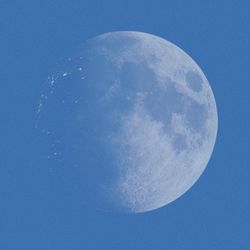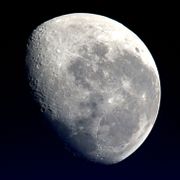Luna

|
Article under construction
This article is in the pre-production phase, and is thus largely unwritten. The author(s) apologise for the inconvenience.
|
| Department of Luna | ||
| Seal | ||

| ||
| The Moon, as seen from the northern hemisphere during daylight | ||
| Department | ||
| Government: | Department of the Commonwealth of Earth | |
| Department Minister: | Nikita Sood | |
| Colonised: | 2038 | |
| Founded: | 2180 | |
| Currency: | Commonwealth Dollar ($) | |
| Demonym: | Lunar | |
| Geography | ||
| Planet: | Earth | |
| System: | Solar System | |
| Avg. distance from Earth: | 384,402 km | |
| Demographics | ||
| Population: | 55 million | |
| [Source] | ||
The Department of Luna (Martian English: Dipamendluuna) is the official political designation of the Earth's Moon, regarded accordingly to avoid confusion with the multiple other moons of the Solar System, although the colloquial "The Moon" remains in common Earther speech. The Moon was colonised in 2180 primarily for the mining of helium-3 for use in fusion reactors back on Earth, however it has in the following millennia also become a useful international zone for trans-Commonwealth efforts, including: as an international spaceport, for Commonwealth-funded research and development, and for housing most of the Commonwealth-controlled military hardware.
To shield from solar radiation, most of Luna's civilian structures are built under its surface.
History[edit | edit source]
Early Centuries[edit | edit source]
The Moon was the first extraterrestrial body landed on by humankind, and is held with a special nationalistic sentiment because of such by Commonwealth regime. The Soviet Luna 2 was the first artificial probe to successfully land on its surface in 1959, with the first humans walking on lunar soil being the crew of the United States' Apollo 11 mission in 1969.
Plans for colonisation stretch almost as far back as the first moon landings, however it was not until 2038 were the first semi-permanent colonies set up by the People's Republic of China, with later bases being built by the Russian Federation and United States. The first colonies were strictly scientific in nature, with each base typically being staffed by small crews of 5-7 people.
In 2190, bowing to significant pressure by energy and mining conglomerates - amongst other corporate, governmental and civilian entities -, the Department of Luna was officially declared by the United Nations, with the lunar surface being zoned for scientific and strictly limited industrial projects, with the first permanent colonies being depots for refining sifted lunar dust for helium-3 for to be used in fusion reactors back on Earth.
International Spaceport[edit | edit source]
Commonwealth Wars, Luna Raids, and Great Interstellar War[edit | edit source]
Recent Centuries[edit | edit source]
Geography[edit | edit source]
Habitability[edit | edit source]
Government[edit | edit source]
Politics[edit | edit source]
Military[edit | edit source]
Economy[edit | edit source]
Overview[edit | edit source]
The economy of Luna is driven by its international spaceport and the service industry that supports that spaceport and the diplomatic corps. Corporations such as Axil Industries (until recently), INTPOL, and Argonaut Inc. with dealings on Earth have headquarters on Luna. Helium-3 mining used to be a big industry on Luna, but those mines have been dry for millennia. Luna's underworld is also awash with activity, as the moon's international spaceport provides a good avenue for the exchange of goods from across known space.
Health[edit | edit source]
Migration[edit | edit source]
Immigration to Luna is a constant, mostly from Earth and the Outer Planets. This immigration provides the majority of Luna's population, and it has for a very long time. Also, the diplomatic corps from various parts of governed space provide a small but significant source of immigration to Luna.
Migration from Earth most significantly comes from the North American arcologies, who have dominated Earth's government for much of its history and who culturally fit in the most with locals. Meanwhile, recently there has been more immigration from the Chinese arcologies due the recent shift in power in favor of the Xin Xiwang government.
Energy[edit | edit source]
Science and technology[edit | edit source]
Transport[edit | edit source]
Culture[edit | edit source]
Architecture[edit | edit source]
Luna's architecture is largely brutalist and subterranean with its civilian structures built under the surface. These influences come from millennia of influences from bureaucratic Earthers who favored that style of architecture.
Demographics[edit | edit source]
The population of Luna is highly cosmopolitan and fluid, with large numbers of immigrants coming in every generation from Earth and other planets. Lunarians meanwhile maintain their population through stable birthrates while immigrants usually either eventually leave or have sub-replacement birthrates. The immigrant population has been renewed nonetheless over the years through almost constant immigration, though its proportion of Luna's population has varied over the millennia.
Ethnicity[edit | edit source]
Due to its close proximity to Earth and its status as Earth's first extraterrestrial possession, Luna has always had a fairly cosmopolitan population composed largely of transplants from Earth and more recently some other planets. Lunarians are racially and culturally diverse with many influences. The majority of Luna's population are still from off-world, mostly from Earth. These new arrivals compose the large portion of Luna's diplomatic corp, service staff, and military personnel with native Lunarians, being in the minority, largely being employed in the moon's expansive international spaceport as industrial workers or other menial labor roles. This had led to degree of hostility from some Lunarians towards outsiders, though usually not Earthers. Native Lunarians make up perhaps a fourth of the population while the rest of Luna are from off-world.
Cohesive communities on Luna include Martians and Saturnians, both of whom inhabit Luna in lieu of living on Earth. Martians on Luna are largely included within the larger Earth Martian community and retain a general working class background. Meanwhile, Saturnians on Luna usually have corporate connections and are in the upper echelons of society.
Language[edit | edit source]
The dominant language on Luna is Solar English, as imposed by the Commonwealth of Earth. There is a Lunarian accent for Commonwealth English and several other languages spoken by Luna's diverse population, but a separate language has not developed because of continuous close proximity to Earth. Other languages including Arabic, Solar Chinese, Solar Russian, Hindi, Martian English, Saturnian English, and a variety of more localized Earth languages.
Religion[edit | edit source]
Luna's religious population is mostly composed of adherents of Christianislam, DVYNE, Martian folk religion, and Resurrectionism. The diplomatic corps from various planets hold even more diverse religious beliefs. Still, the majority of the population are irreligious or agnostic.
Stereotypes[edit | edit source]
Lunarians are typically perceived to be cosmopolitan, racially diverse, and bereft of their own culture separate from Earth. This common stereotype has led to a great deal of resentment among some Lunarians, who have either embraced their diversity or attempted to make their own unique cultural contributions usually with little lasting success in both cases. Lunarians are also stereotyped as being highly resilient in the face of disaster as displayed during the Commonwealth Wars and the Great Interstellar War when Luna was viciously targeted by Belter pirates and the Martian Federation under ALIAS. This resilience has factored into a sort of self-image among Lunarians that they are tough enough to weather any hardship.
